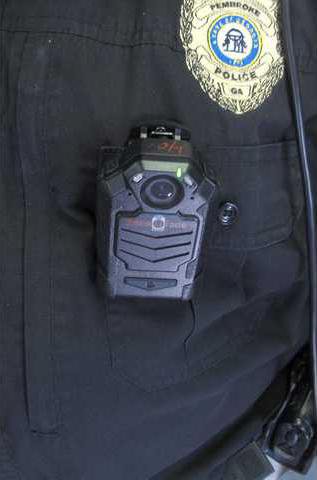The Pembroke Police Department has acquired 10 body cameras and already is using them, police Chief Randy Alexander said.
The cameras, which were purchased with a grant, were put into use Dec. 2.
Alexander said he has wanted to have his officers equipped with body cameras since he arrived in Pembroke a year ago. The Guyton Police Department had them for several years when he was chief there. Body cameras, he said, help tell “the whole story” of an incident that cellphone cameras may not fully capture.
“It’s a check and a balance,” Alexander said. “We want citizens to know we’re open, that we’re transparent, that we have nothing hide.”
The department also received 10 new sets of body armor through the grant. The Safety and Liability Grant, which came from the Georgia Municipal Association, is for $10,000 and just covers the equipment’s cost of $9,999, said Sharroll Fanslau, the director of the Pembroke Downtown Development Authority.
The body cameras are the Prima Facie brand by Safety Vision. According to the specification sheet on SafetyVision.com, each camera is 2.3 inches by 3.66 inches by 1.66 inches and weighs about one-third of a pound. The camera is attached to the front of the officer’s uniform in various spots, depending on the height of the officer.
Each camera is set on standby. The website says the camera has up to five hours of recording time.
When an officer brings a camera into the police station, the video gets downloaded into a computer. Officers can only download and review each video; they can’t edit or delete. Only designated individuals — the lead investigator or the clerk of courts — can make any changes.
“I can’t even go into certain cameras,” Alexander said.
The Safety Vision website adds that the camera has an internal storage in order to prevent tampering.
The intricate policy laid out for the cameras’ use includes the format for when to turn on the cameras and when the situation calls for privacy. One thing PPD officers will do is let people know that they’re being recorded in a situation. Alexander said some agencies’ policies don’t want their officers doing that, but the chief said his experience is that it helps.
“We found out, through trial and error, you tell them it’s on, most of the time they’ll de-escalate,” Alexander said. “The situation calmed down. They know they’re on camera, things change.”
The recordings are considered open records and will help officers be more efficient with writing their reports, he said.
Each camera has an infrared feature, which automatically activates when the light level is low enough, Alexander said.
The new armor, which replaces some of the armor last bought several years ago, is worn on the outside of the shirt in a carrier. Alexander said this version of armor is more comfortable and probably lasts a little longer than the armor the officers previously used.

